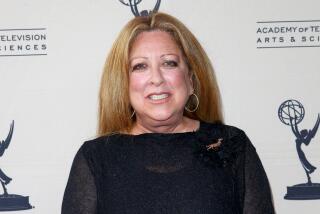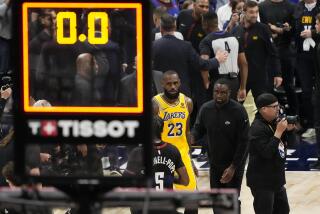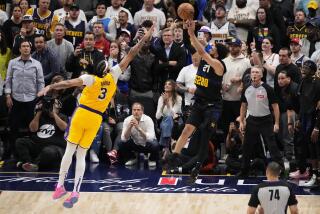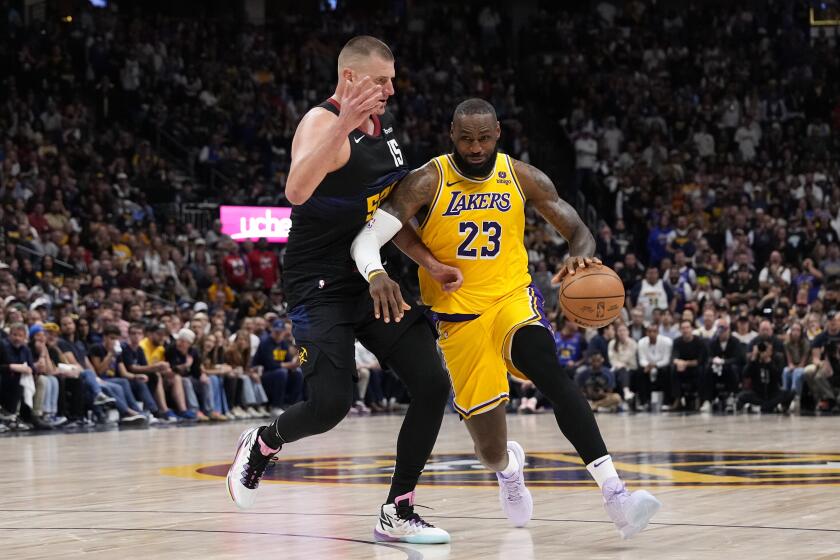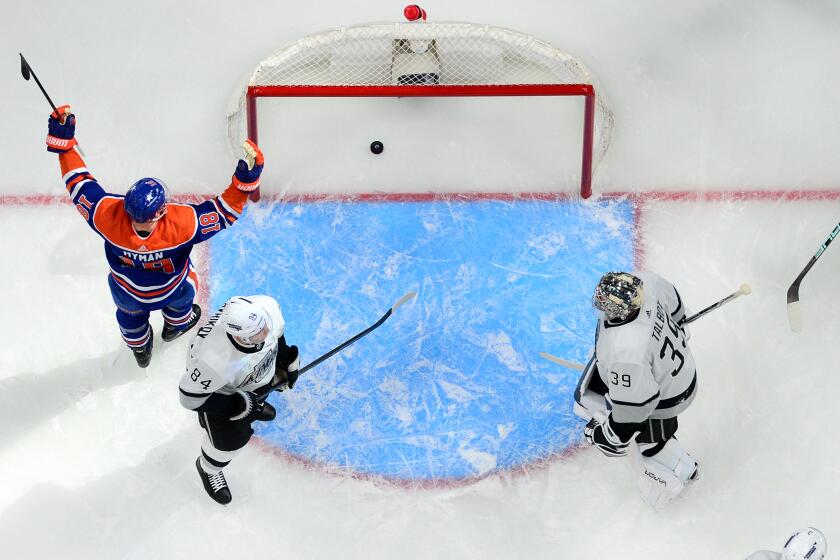Young gay athletes find a place out on the field
THE guys in his boat took to calling him “Badger” because of the grimace he wore during races. Part of a junior rowing club that ranked among the fastest in the nation, Lucas Goodman was relentless on the water.
It was a different story on land.
The teenager with the powerful build and close-set eyes had to be careful. He hung back ever so slightly when teammates shot the breeze, talking about girls.
“You get tired of constantly watching what you say, constantly watching how you act,” he said. “You’re almost paranoid.”
Goodman felt so uneasy that he finally told the Green Lake Crew his secret: He is gay.
The 18-year-old belongs to an emerging generation of openly gay and lesbian athletes on high school and college campuses across the country. These young men and women are quietly venturing where no pro football or baseball star has gone, challenging the conformist, if not downright homophobic, tradition of the playing fields.
Their numbers are difficult to gauge because many confide only in peers. Experts chart the trend anecdotally through athletes who join gay rights clubs at school, e-mail gay rights advocates for advice or announce their sexual orientation on websites such as Facebook and MySpace.
“This is an issue that’s in transition even as we speak,” said Jay Coakley, a noted scholar and author on sports culture. “We’re looking at how the world is changing.”
Not all the stories have happy endings -- a high school football player in Northern California tells of being ostracized. But others, such as a Delaware runner and a Georgia hockey player, say they were welcomed by their teams.
Sociologists see the openness as a generational shift. Polls suggest a growing percentage of young people have more relaxed views about sexual orientation than their parents did.
In Seattle, Goodman began dropping hints around his eight-man boat more than a year ago. He talked with his best friend, and with another rower who seemed both understanding and physically large enough to make a good ally.
When word spread, no one teased or whispered about him. The crew saves money by sharing hotel beds on the road, and the teammate who bunks with Goodman didn’t mind.
“So what if I sleep in the same bed with a straight guy or with Lucas?” Casey Ellis asked. “Either way, there’s going to be another guy there with me.”
Within a few weeks, Goodman figures, the surprise of his announcement wore off and “it ended up not being that big a deal.”
Which is what makes his story, and others like it, a very big deal.
ALLAN Acevedo tends to speak hurriedly, words stacking up against each other. Finished with his morning run of three miles, sitting in a coffeehouse, the thin young man with dark sideburns rushes through a telling anecdote.
Two years ago, he and the rest of the track team from Bonita High School in La Verne were talking idly before a meet.
“When I get married,” he recalled saying, “the guy has to be -- “
A teammate interrupted. “Did you say guy?”
“Oh,” Acevedo replied. “You didn’t know?”
Young athletes come out for various reasons. Goodman tired of pretending to like girls. Acevedo had something different in mind.
He volunteers for gay rights groups and said he once tried to enlist in the military to confront the “don’t ask, don’t tell” policy. When he insisted on telling, he said, the recruiter declined to complete his paperwork.
Acevedo joined the track team partly for love of the sport and partly to break stereotypes: “I wanted to say that I’m more than just gay.”
Some teammates at Bonita High quietly switched aisles in the locker room, he said. Others seemed to run harder in practice, apparently determined not to lose to a gay guy.
Acevedo was undeterred, and was open about his sexual orientation when he transferred to a Chula Vista school. At 18, he finds support in a development that encourages other young gay athletes: a shift in public opinion.
A 2007 Gallup poll found that 57% of Americans viewed homosexuality as an “acceptable alternative lifestyle,” an increase of 11 percentage points from four years ago. The percentage was higher among 18- to 29-year-olds.
Almost three-quarters of heterosexual adults said they would not change their feelings toward a favorite male athlete if he came out, according to a recent survey by Harris Interactive and Witeck-Combs Communications.
“It’s not like the old days,” said David Kopay, a former National Football League player who stirred controversy by announcing he was homosexual in 1975.
Back then, gay athletes felt compelled to keep quiet, fearing hostile locker rooms and coaches who might cut them from the team.
Like Kopay, others waited until retirement to come out. In baseball, there were former Dodgers Glenn Burke and Billy Bean; in football, Roy Simmons of the Washington Redskins and, five years ago, Esera Tuaolo of the Green Bay Packers.
John Amaechi revealed his sexual orientation in a recent autobiography, “Man in the Middle,” published after he left the Utah Jazz of the National Basketball Assn. He sensed the change in attitude when he visited a Southern college campus during a promotional tour.
“A bunch of shirtless frat guys playing volleyball recognized me and started yelling,” he said. “They were saying that they love what I’m doing.”
Joey Fisher encountered a similar response at the University of Georgia, where his teammates recall thinking, Wow, gay people play hockey? when the goalie came out. No one mentioned anything to him at first.
But then, Fisher said, “about three days into training camp, one of my teammates tried to set me up with a friend of his. A guy.”
Heterosexuals aren’t the only ones acclimating to the idea of homosexuals in sports, Acevedo said. His gay friends were initially shocked when he ventured into the world of jocks.
“They said, ‘You should wear a pink shirt,’ ” he recalled. “But then a lot of my friends went to my races.”
Acevedo possesses a resilience common to athletes interviewed for this article. A fight with his parents -- mainly over his sexual orientation -- prompted him to move in with an older sister. He worked two jobs to support himself, which meant skipping track his senior year.
After graduating in the spring, he took a summer internship with a gay rights group in Washington, D.C., where he continues running on his own, staying in shape to try out for the team at San Diego State this fall.
“When I get there,” he said, “I’ll come out again.”
THERE were no big announcements, no heartfelt talks in the locker room. As a freshman at Harvard, Sarah Vaillancourt simply decided to stop hiding her sexual orientation.
Whenever the subject of dating or relationships arose, she spoke frankly.
“If they weren’t going to accept me on the team,” she said, “I wasn’t going to stay.”
It helped that Vaillancourt quickly established herself among the top scorers on her college hockey squad and a rising star for Team Canada back home in Quebec. But she knew that as a lesbian, she would encounter challenges different from those facing gay male athletes.
On the plus side, she grew up with role models such as Billie Jean King and Martina Navratilova in tennis, Sheryl Swoopes in basketball and Rosie Jones in golf. Fans have come to expect a certain percentage of lesbians in women’s sports.
This expectation also counts as a negative. In some circles, athletic women are automatically presumed to be lesbians, which can spark resentment among straight athletes.
Caitlin Cahow, a Harvard player and member of the U.S. women’s hockey team, said: “Rumors get started and that makes everyone defensive about their sexuality, gay or straight. That’s when it becomes a problem.”
Vaillancourt, so candid at Harvard, acknowledges she is more cautious around the Canadian national team.
“They don’t want me to talk about it so much, because if one person comes out, everyone’s [going to be labeled] a lesbian,” she said. “My whole team is not lesbian.”
In college sports, negative recruiting is another concern. Some coaches try to scare high school prospects away from rival programs by suggesting those teams are predominantly lesbian. Kathy Olivier, the UCLA women’s basketball coach, blames a hyper-competitiveness fueled by large coaching salaries.
“These are big-time positions,” Olivier said. “I feel like some coaches would do anything.”
At the University of Delaware, runner Lauren Stephenson said that coming out brought her closer to teammates.
Stephenson announced her sexual orientation as a junior, trying to soften the blow by saying she was bisexual. Soon, she found herself consoled in the locker room after a girlfriend cheated on her.
“All my teammates were telling me, ‘You’re so much hotter than she is, what is she thinking?’ ” Stephenson said. “It was just amazing.”
Vaillancourt has had similar experiences in hockey, a sport she discovered as a toddler watching her brother play.
She has always been strong-willed, with a hint of defiance in her French Canadian accent and the arch of her eyebrows. Her parents worried when she came out in college.
“I know how people react sometimes,” her mother, Monique, said. “People can be bad and mean.”
Harvard players said they quickly warmed to Vaillancourt’s wit and self-confidence and her straightforward manner in speaking about her sexual orientation. Off the team, some classmates did not react as kindly.
“I think it’s because they don’t have gay friends,” said Laura Brady, a Harvard forward. “They just don’t know.”
Vaillancourt, now a 22-year-old junior, occasionally wonders about all the fuss. With so much of her time spent playing hockey and studying, “being gay is only a small part of who I am,” she said.
In moments of impatience, she reminds herself that some people struggle to accept homosexuality for religious and other deep-seated reasons.
“You have to give people a chance to get used to all this,” she said.
THE gym door was locked when Brian Schwind and his football teammates trudged off the practice field that day almost three years ago. As they waited for coaches with a key, Schwind realized he was surrounded.
The sophomore was new to Foothill High School near Redding. By football standards he was smallish, a special teams player who stood only 5 feet 7. The larger players crowding around him demanded to know: Was he gay?
“Either I could tell the truth and have the crap beat out of me or I could lie and save myself,” Schwind said. “My mom always told me to stand up for what I believe, so I told them.”
A linebacker stepped in to prevent further trouble, but for the rest of the fall Schwind felt ostracized. After football, he went out for wrestling.
“Nobody wanted to wrestle with me,” he recalled. “During weigh-ins, everybody was like, ‘Get him out of the room.’ ”
His experience offers a reminder that poll numbers and television ratings for “Will & Grace” do not always translate to the schoolyard.
A 2005 survey by the Gay, Lesbian and Straight Education Network found that 64% of homosexual students had experienced some form of harassment in school. Gay rights groups cite higher suicide rates among homosexual teens, though the statistics are not universally accepted.
In sports, young gays face a paradox. The social status of playing athletics gives them a better chance of being accepted, but they must confront long-held biases.
The locker room can be especially tricky for boys. Corey Johnson, who in 1999 came out to his high school football team in Massachusetts, addressed the issue of shared showers and locker rooms head-on.
“I didn’t touch you last year and I’m not going to do it this year,” he told his teammates, adding: “And who says you guys are cute enough, anyway?”
The joke elicited a nervous ripple of laughter.
At Washington University in St. Louis, Adam Goslin came out as a sophomore in 2004 and was welcomed by the football team. But the 6-foot-3, 220-pound defensive lineman often overheard teammates toss around homophobic slurs common to the locker room. Even players sensitive to his feelings could not always help themselves.
“I’ve had a couple of close friends tell me, ‘I’m really trying not to, but I’ve been saying it for so many years and sometimes it slips out,’ ” he said.
The atmosphere confronting Schwind in Redding was more difficult.
Outed by the football team, he became more assertive, trying to form a club for gay students on the small-town campus. His efforts seemed to antagonize some athletes at a time when wrestling coach Jerry Vallotton was working hard to build Foothill High’s program, with team unity a key element.
Schwind was new to the school “and that in itself is difficult,” Vallotton said in a recent interview. “Then if you carry a banner for another cause, whatever that cause may be, that’s a double whammy.”
The coach said he thought “all parties did the best they could.”
By his junior year, Schwind gave up football and wrestling, sticking to swimming, where he felt more accepted. The experience has prompted him to consider a career in civil rights law.
“There can be a closed-minded shell around sports,” he said. “Definitely, high school had a huge effect on my ideals about how things should be.”
WHEN Lucas Goodman thought about coming out, he wasn’t terribly concerned about acceptance -- not as an accomplished rower and honors student headed to MIT this fall. He knew that Seattle had a large gay population and that crew was “one of the most elitist liberal yuppie sports you could think of.”
Goodman was more fearful that his sexual orientation might overshadow everything else.
“I want to be known as a rower,” he said. “Not as the gay kid.”
Gay rights advocates are just as eager for openly homosexual athletes to become so common that the issue fades away. That is why they place such hope in the new generation.
“A superstar coming out -- I think it will happen, but I don’t think that’s how you create enormous change,” said Johnson, the former high school football player, who now works as a media strategist for the Gay & Lesbian Alliance Against Defamation.
“You have enormous change with story after story about young people having positive experiences.”
Goodman has already made a difference with the Green Lake Crew.
“Your impulse is not to talk about it because you don’t know if that’s private information or not,” Coach Ed Maxwell said. “But the more you know and the more you understand about people who are different from you, the better off you are.”
The experience has helped Goodman too.
He still rows fiercely, still bugs teammates about eating right and getting sleep before races. But now he is happier.
On a recent afternoon, the rowers shouldered their sleek boat to the edge of a small lake north of downtown. They were in a good mood after winning a silver medal at the U.S. Rowing Youth National Championship, joking and laughing, talking about parties.
It was the type of chatter that used to make Goodman nervous. Not anymore.
More to Read
Get our high school sports newsletter
Prep Rally is devoted to the SoCal high school sports experience, bringing you scores, stories and a behind-the-scenes look at what makes prep sports so popular.
You may occasionally receive promotional content from the Los Angeles Times.
